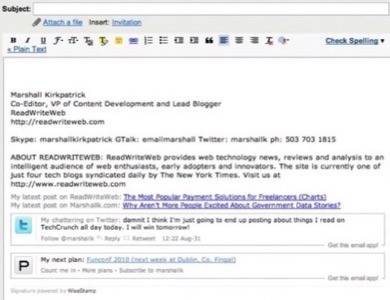Email is old fashioned, right? Not so fast – that rich source of data about your personal connections and interests is finally emerging as a platform for some really innovative services.

Yesterday we saw the launch of Gmail’s new Priority Inbox, which automatically sorts inbound messages by priority. That’s something we’ve been expecting since hints of it emerged 18 months ago. This Spring, Gmail began offering secure, programatic access permission for the contents of your inbox – a move we said heralded a new era of inbox applications. Now we’re finally seeing that flood of services emerge. Here are three of the best new email apps that you don’t want to miss. Following screenshots and a screencast, we discuss what it all means and how these are just the beginning of the coming era of email as a platform.
Rapportive
Rapportive is a browser plug-in we wrote about this Spring, but we still see people saying “I don’t know how I lived without this” months later. For now it’s simple: the program looks at the adress you’ve received an email from and displays social network data, job titles and locations in the sidebar of your browser. Rapportive has a lot more planned, but you’ll be amazed to see how much even this adds to your email experience. The one down side? It’s not very easy to correct the information Rapportive shows about you or other people.
You may have already added Rapportive, though. Read on for more applications you probably haven’t begun using yet.
How This Leverages Email as a Platform
Email as identity indicator, plus that identity as hub for data aggregation, equals awesome.

WiseStamp
WiseStamp is a browser plug-in that makes it easy to automatically add dynamic content to your email signature. TechCrunch just wrote about the service opening up to the public today.
In five minutes, I set up WiseStamp to automatically add a link to the most recent article I’ve written here on ReadWriteWeb, the most recent post I’ve written on my personal blog , my most recent message from Twitter and my next published plan via my Plancast account.
How This Leverages Email as a Platform
WiseStamp mashes up the communication platform of email with streams of our personal syndicated published content. This is a great example of how feeds of content can enrich our everyday lives. In this case, there’s nothing in our emails being analyzed, but email’s communication capabilities (and what really beats email for communication, still?) are built upon and added to by WiseStamp.

The Killer App: Greplin
Also first written about on TechCrunch today (grrrr….) is Greplin, an incredible cloud-based search service that indexes and adds to a universal personal search box the contents of your emails, calendar, Twitter, Facebook, LinkedIn, BaseCamp, Evernote, Salesforce and more.
It is, if it works as well as it says it does, a dream come true. Don’t remember which communication service a message came through? Greplin will solve that problem.
Uber-geek Stephan Wolfram has a service he had built for him personally that allows him to search through 25 years of emails and 20 years of his clicks around the web, papers written and more. That sounds incredible. If Greplin indexed the full page text of every link I clicked on and the messages sent by all my friends on services like Twitter and Facebook, then organized search results in a way that was easy to use – I would totally pay for that.
For now, I’m just waiting for my access to be granted to the basic service.
How This Leverages Email as a Platform
Search may not be the ultimate platform – recommendation probably is. This service reminds me of SystemOne, an incredible product that analyzes the semantics of text that you’re typing and recommends related content from your email, documents and selected RSS feeds. That product was probably ahead of its time, it’s not fully in the cloud and it’s not free.
Greplin searches a whole lot for free, and if it can do this much at launch – it’s exciting to think about what it could do in the future. Recommendation would be my request, in a browser plug-in. Imagine typing out an email and getting a little notice somewhere that Grepplin has found some emails that are genuinely relevant to what you’re typing at the moment. That would be awesome. The sky’s the limit when you can quickly process huge stores of your own personal data, though.
Greplin Demo from greplin on Vimeo.
Why These Are Only the Beginning
We’ve been waiting for years for email to emerge as a platform. The key enabling factor that has now emerged is a secure way to grant temporary access to the contents of your email to trusted developers out in the larger ecosystem of people and companies who want to build these new services – all without ever giving them your precious email password.
That’s what OAuth (the Open Authentication Standard) has enabled: it provides one standardized way for any email provider and any application developer to grant or request secure, temporary access to your personal information without giving away your password. OAuth lets your email provider, in this case, vouch for you to these other apps and give them your info, while never exposing your password.
OAuth is an incredible platform enabler. Just yesterday Twitter began enforcing the requirement that its ecosystem of developers use it instead of ever asking for your account password. Gmail has OAuth for IMAP email access and Yahoo! is working with them to turn that, too, into a standard.
Oauth has been in development for some time and in the Spring of 2009, the protocol had a close scrape with a big security vulnerability related to Twitter’s initial implementation. Fortunately, the technical community acted fast and fixed the problem before it blew up in the faces of OAuth’s advocates.
The man who led those efforts to save OAuth from that problem was Eran Hammer-Lahav, at Yahoo! (“How the OAuth Security Battle Was Won, Open Web Style“)
Hammer-Lahav took a step back from his key work on OAuth earlier this year – and can you guess what he’s working on now at Yahoo?
Email as a platform.
Hammer-Lahav is one of the smartest developer advocates in the consumer web business, and here’s how he explains the potential and the pitfalls of email as a platform:
It’s pretty clear that email provides a huge potential for extensibility, given the wide range of ways people use it. The inbox is much more than just a place for incoming mail, it is the primary dashboard for many web users – it is how they manage their lives.
So when looking at email as a platform, the opportunity of making it more useful and productive reaches most areas of online activities.
So far the focus has been on taking social information to help better manage email overflow, but the platform has much more potential beyond that.
We are constantly looking at how we can help Y! Mail users be more productive and connect to the people they really care about. For example, sharing photos is a big email experience – using email as a platform to make private photo sharing easier (as easy as sharing photos on Flickr or Facebook) is the tip of the iceberg.
The tricky part, like any platform, is how to manage your developer community, and how to safely distribute applications. This is particularly tricky in mail which is the most critical and private part of your online identity (all password resents, most private communications, etc.)
In addition, the lack of a standard way to extend email leads to a fragmented market – one which has yet to emerge as a profitable destination for third party developer.
At Y!, we are constantly looking for ways to provide deeper access to our mail platform, both using APIs and as an application framework for extensions. It is also how we develop mail experiences internally, such as inline image and video views, image sharing, invites, and many other use-case specific applications.
Personal data, securely shared, is an untapped gold mine for both literal business development and incredible new user experiences. The services highlighted here are exciting – but they’re just the beginning.










